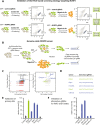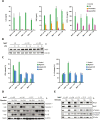A Genome-wide CRISPR (Clustered Regularly Interspaced Short Palindromic Repeats) Screen Identifies NEK7 as an Essential Component of NLRP3 Inflammasome Activation
- PMID: 26553871
- PMCID: PMC4697147
- DOI: 10.1074/jbc.C115.700492
A Genome-wide CRISPR (Clustered Regularly Interspaced Short Palindromic Repeats) Screen Identifies NEK7 as an Essential Component of NLRP3 Inflammasome Activation
Abstract
Inflammasomes are high molecular weight protein complexes that assemble in the cytosol upon pathogen encounter. This results in caspase-1-dependent pro-inflammatory cytokine maturation, as well as a special type of cell death, known as pyroptosis. The Nlrp3 inflammasome plays a pivotal role in pathogen defense, but at the same time, its activity has also been implicated in many common sterile inflammatory conditions. To this effect, several studies have identified Nlrp3 inflammasome engagement in a number of common human diseases such as atherosclerosis, type 2 diabetes, Alzheimer disease, or gout. Although it has been shown that known Nlrp3 stimuli converge on potassium ion efflux upstream of Nlrp3 activation, the exact molecular mechanism of Nlrp3 activation remains elusive. Here, we describe a genome-wide CRISPR/Cas9 screen in immortalized mouse macrophages aiming at the unbiased identification of gene products involved in Nlrp3 inflammasome activation. We employed a FACS-based screen for Nlrp3-dependent cell death, using the ionophoric compound nigericin as a potassium efflux-inducing stimulus. Using a genome-wide guide RNA (gRNA) library, we found that targeting Nek7 rescued macrophages from nigericin-induced lethality. Subsequent studies revealed that murine macrophages deficient in Nek7 displayed a largely blunted Nlrp3 inflammasome response, whereas Aim2-mediated inflammasome activation proved to be fully intact. Although the mechanism of Nek7 functioning upstream of Nlrp3 yet remains elusive, these studies provide a first genetic handle of a component that specifically functions upstream of Nlrp3.
Keywords: NEK7; NLRP3; caspase 1 (CASP1); cell death; genetic screen; inflammasome; inflammation; pyroptosis.
© 2016 by The American Society for Biochemistry and Molecular Biology, Inc.
Figures


References
-
- Medzhitov R. (2007) Recognition of microorganisms and activation of the immune response. Nature 449, 819–826 - PubMed
-
- Gross O., Thomas C. J., Guarda G., and Tschopp J. (2011) The inflammasome: an integrated view. Immunol. Rev. 243, 136–151 - PubMed
-
- Kayagaki N., Stowe I. B., Lee B. L., O'Rourke K., Anderson K., Warming S., Cuellar T., Haley B., Roose-Girma M., Phung Q. T., Liu P. S., Lill J. R., Li H., Wu J., Kummerfeld S., Zhang J., Lee W. P., Snipas S. J., Salvesen G. S., Morris L. X., Fitzgerald L., Zhang Y., Bertram E. M., Goodnow C. C., and Dixit V. M. (2015) Caspase-11 cleaves gasdermin D for non-canonical inflammasome signaling. Nature 526, 666–671 - PubMed
-
- Shi J., Zhao Y., Wang K., Shi X., Wang Y., Huang H., Zhuang Y., Cai T., Wang F., and Shao F. (2015) Cleavage of GSDMD by inflammatory caspases determines pyroptotic cell death. Nature 526, 660–665 - PubMed
Publication types
MeSH terms
Substances
LinkOut - more resources
Full Text Sources
Other Literature Sources
Molecular Biology Databases
Miscellaneous

